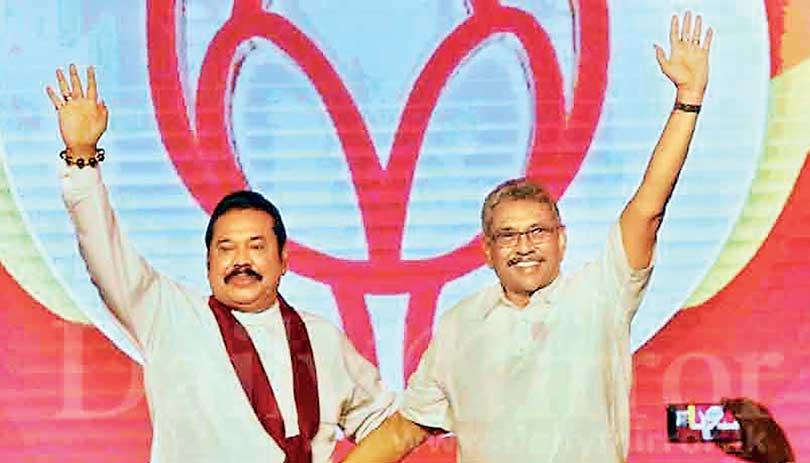Reply To:
Name - Reply Comment

Prime Minister Mahinda Rajapaksa with President Gotabaya Rajapaksa
By Nilanthi Samaranayake
The return of the Rajapaksa family to the leadership of Sri Lanka raises questions about how the country’s foreign policy approaches to India, China and the United States may change. Media reporting immediately after the November 16 election expressed apprehension about Sri Lanka returning to China’s orbit after a presidential campaign marked by strong anti-US sentiment.
Now that the Rajapaksas have reclaimed both the presidency and prime ministership, what direction will Sri Lanka’s foreign policy take?
After being sworn in as president, Gotabaya Rajapaksa switched to English in his inaugural speech to reinforce Sri Lanka’s traditional articulation of its foreign policy approach: ‘We want to remain neutral in our foreign relations and stay out of any conflicts amongst the world powers’.
The idea that Sri Lanka can swing toward a pro-India or a pro-China disposition with a change of leadership belies the constraints on smaller South Asian states in a region that is still dominated by India and increasingly contested by China — and where other major powers such as the United States and Japan play critical roles.
These smaller states do not have the luxury of choosing exclusive relations with one country when pursuing national development goals. This is especially the case with Sri Lanka, which is currently facing the perils of the ‘middle-income trap’ (rather than a ‘Chinese debt trap’). As it has graduated in income status, the country has lost access to concessional assistance. Sri Lanka relied on debt financing during earlier Rajapaksa governments as well as under the outgoing administration.
Wartime cooperation
During the first Rajapaksa era (2005–2015), Sri Lanka maintained close operational cooperation with India in wartime. Following the end of the civil war in 2009, the Rajapaksa government established a bilateral defence dialogue with India in 2012 that continued under the successive leadership and signed a contract for an Indian shipyard to build offshore patrol vessels for the Sri Lanka Navy.
Yet ties plummeted after Sri Lanka allowed a Chinese submarine to pay two visits to Colombo Port in 2014. The country welcomes most warships stopping to rest and refuel in the central Indian Ocean, but its decision to permit a Chinese submarine to do so was viewed by India’s new Narendra Modi government — with which bilateral ties had improved — as a challenge
to India.
Another major source of tension between India and Sri Lanka, particularly during the Manmohan Singh administration, was the treatment of ethnic minorities. The Rajapaksa government will need to set a tone of domestic inclusiveness as it considers foreign policy toward India. New Delhi will be alert to this issue given India’s sizable Tamil population.
Top exporting partner
The United States remains Sri Lanka’s top exporting partner, providing vital income for the economically challenged nation with a debt-to-GDP ratio of 83 per cent. To what extent will Washington leverage its economic position to encourage the new government to focus on post-war reconciliation and accountability? This remains an open question under the current US administration, but the previous Obama administration made human rights a priority in its Sri Lanka policy during the Rajapaksa years.
More recently, strategic issues, such as concluding a Status of Forces Agreement to give rights to visiting US military personnel, have gained increased prominence. To India’s dismay, the previous Rajapaksa government concluded an Acquisition and Cross-Servicing Agreement with the United States, illustrating Sri Lanka’s foreign policy tradition of maintaining strategic ties with various major powers.
Sri Lanka’s interactions with China will continue to be the most scrutinised of the country’s bilateral relationships. Despite predictions to the contrary, the outgoing coalition government did not depart significantly from the direction of Rajapaksa-era policies toward China. This includes its decision to negotiate a 99-year lease of Hambantota port operations to a Chinese-majority joint venture as well as the transfer of the offshore patrol vessel SLNS Parakramabahu from China.
The new Rajapaksa government could benefit from US assistance under the Indo-Pacific Strategy’s Infrastructure Transaction and Assistance Network, Transaction Advisory Fund and Commercial Law Development Programme to fulfil its campaign pledge to revisit the lease for Hambantota Port. In his first interview as president, Gotabaya Rajapaksa affirmed his desire to renegotiate the port agreement.
Upper middle-income status
More fundamentally, Sri Lanka’s long-term problems with debt are only intensifying as it has recently achieved upper middle-income status. This means that even fewer options for concessional loans will be available, especially as Sri Lanka continues to carry significant external debt — mostly from market-based loans, multilateral development banks, Japan and China. Loans to China will eventually come due, and US and multilateral assistance in debt management practices and restructuring will be of prime importance for Sri Lanka.
Sri Lanka’s ties with major powers will no doubt be closely studied in the coming year. India, the United States, Australia and Japan have contributed to enhance Sri Lanka’s maritime security capacity, which is essential for economic development. The United States has even approved a grant of nearly half a billion dollars to fund transportation infrastructure throughout the island, which the new government is considering whether to sign.
These countries are well positioned to offer Sri Lanka alternative options to China, while applying pressure on the new leadership on issues of reconciliation and human rights.
What is important to remember are the underlying drivers of Sri Lankan foreign policy — often shared by fellow smaller South Asian states.
These include a desire for external assistance to help attain national development goals, recognition of limited capability that does not permit excluding external assistance when available and pursuit of the same sovereign rights expected by large countries.
These factors are important for understanding Sri Lanka’s foreign policy decisions as the country works to achieve development goals and maintain its sovereignty against a backdrop of great-power interests in the Indian Ocean. (Courtesy East Asia Forum)
(Nilanthi Samaranayake is Director of the Strategy and Policy Analysis program at CNA, Arlington, VA.)